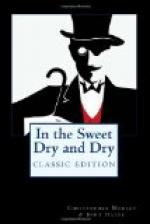“From my earliest days I was accustomed to hear very little else but talk about liquor. The fairy tales that most children are allowed to enjoy merely as stories were explained to me by my father as allegories bearing upon the sinister seductions of drink. Little Red Riding Hood and the Wolf, for instance, became a symbol of young womanhood pursued by the devouring Bronx cocktail. The princess from whose mouth came toads and snakes was (of course) a princess under the influence of creme de menthe. Cinderella was a young girl who had been brought low by taking a dash of brandy in her soup. Every dragon, with which good fairy tales are liberally provided, was the Demon Rum. It is really amazing what stirring prohibition propaganda fairy tales contain if you know how to interpret them.
“All this kind of palaver naturally roused my childish curiosity as to the subject of intoxicants. But, like a docile daughter, I fell into the career marked out for me by my father. I became a militant for the Pan-Antis. I distributed tracts by the million; I wrote a little poem on the idea that the gates of hell are swinging doors with slats. I can honestly say that I never felt any real hankering for liquor until it was prohibited altogether. That is a curious feature of human nature, that as soon as you forbid a thing it becomes irresistibly alluring. You remember the story of Mrs. Bluebeard.
“It occurred to me, after booze had gone, that it was a sad thing that I, Bishop Chuff’s daughter, who was devoting my life to the prohibition cause, should have not the slightest knowledge of the nature of this hideous evil we had been pursuing. I brooded over this a great deal, and fell into a melancholy state. The thought came to me, there must be some virtue in drink, or why would so many people have stubbornly contested its abolition? It would be too long a story to tell you all the details, but it was at that time that I first became aware of my psychic gift.”
“Your psychic gift?” queried Bleak, wondering.
She turned her bright beer-brown eyes upon him gravely. “Yes,” she said, “I am an alcoholic medium. It is the latest and most superior form of spiritualism. By gazing upon crystal— particularly upon an empty tumbler—I am able to throw myself into a trance in which I can communicate with departed spirits. A good drink does not die, you know: its soul hovers radiantly on the twentieth plane, and through the occult power of a medium those who loved it in life can get in touch with it once more. Through these trances of mine I have been privileged to put many bereaved ones in communication with their dear departed spirits. To hear the table-rappings and the shouts of ecstasy you would perceive that a great deal of the anguish of separation is assuaged.”
“Do you often have these trances?” said Bleak, with a certain wistfulness.
“They are not hard to induce,” she said. “All that is necessary for a seance is a round table, preferably of some highly polished brown wood, a brass rail for the worshipers to put their feet on, and an empty tumbler to concentrate the power of yearning. If those present all wish hard enough there is sure to be a successful reunion with the Beyond.”




